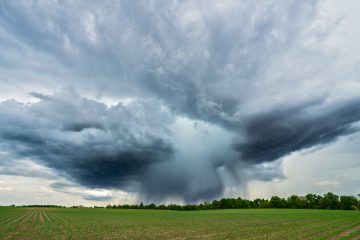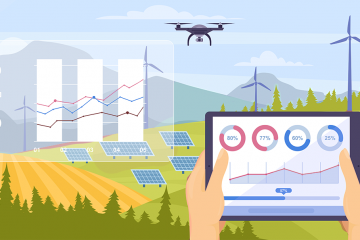Weather is an ordinary topic of conversation that we resort to when we have nothing else to say. On the other hand, it gives a contextual perspective at the start of a novel to set the scene with mood and tone.
In the present day, weather forecasts are easy to access with our smart devices, at any given time. It was made possible only with curated weather data. It has not always been the case with weather forecasting. Going back in time, Admiral Robert FitzRoy, a British Naval Officer who pioneered daily weather predictions and coined the term – “weather forecast”.
Numerous ships sailed into the eye of the storm with an enormous number of lives lost at sea. In 1854, FitzRoy was appointed to collect weather data at sea. After a few years of monitoring weather information, he had the foresight that weather patterns can be tracked. He was convinced that accurate weather predictions could save many lives.
In 1861, FitzRoy started issuing storm warnings despite the pushback from his superiors. On the 1st of August 1861, The Times published the first-ever weather forecast issued by FitzRoy, received severe public backlash questioning the forecast accuracy. Fitzroy’s attempt at weather forecasting was commendable and revolutionary. It led to the Met Office now in London.
Weather forecasting today also holds data validation as a high priority with AI-powered algorithms to deliver the most accurate weather data. This data is integrated into several applications like built-in sailing dashboards to foresee the marine weather conditions and plan their navigation, accordingly.
During World War II, weather forecasts were monopolized for military planning and marine navigation. Thunderstorm forecast postponed the D-Day to invade Normandy. It is still considered to be the most significant weather forecast in history. The victory at Normandy marked the turning point in WWII.
So far, we have seen the weather forecasting application in history. Now, let’s see the present day and future applications of weather data.
Before we look into the use cases, let’s answer a few simple questions for a better understanding of weather data.
What is weather data?
In simple words, weather data is the state of Earth’s atmosphere at a geographical location at a given time. Weather data provides invaluable insights through meteorological parameters like:
- Temperature
- Cloud Cover
- Pressure
- Dew Point
- Precipitation
- Visibility
- Wind Speed
- Wind Gust
- Wind Bearing
Each of these parameters plays a significant role in the weather conditions of a particular location. Weather information usually provides hourly updates with future weather forecasting for 1-2 days.
Where does weather data come from?
At Ambee, weather data is aggregated from combining multiple weather sources – on-ground sensors, satellite imagery, and statistical inference to ensure accuracy and availability of the highest order.
With our proprietary technology called AIONN (Aggregation & Interpolation Over Neural Network), 200mX200m hyperlocal weather data resolution is made possible. This technology combines a model trained on historical weather data from weather radars, satellite information, and Gaussian interpolation gets us weather data for the world.
Impact of Weather on Industry Sectors
Weather data is invaluable to many weather-sensitive industry sectors. Namely:
- Agriculture
- Aviation
- Renewable Energy
- Finance
Agriculture
Weather data is the most important element that affects agriculture production. It impacts total yield, crop growth, pest, and irrigation. Farmers pray for suitable weather conditions for their crops. However, weather is subject to unpredictable change especially due to global warming and climate change. A farmer cannot control the weather, but he can be prepared for the future with agriculture weather forecasting.
Accurate weather data with technology can help farmers plan their daily and seasonal activities. Weather information can be made easily accessible through mobile applications, weather dashboards, and live weather maps. They provide hyperlocal weather data with action-driven insights and recommendations to optimize their plan for planting crops, irrigation scheduling, crop fertilization, and crop protection. This will make sure to provide profitable crop production and management.
Aviation
Each pilot before a flight take off asks one question: What is the weather forecast for today?
Weather data plays a significant role in aviation as it affects the safety and security of pilots, crew, and passengers. A plane travels at varying altitudes with varying weather conditions. This information needs to be available to the pilots and crew at hand. Variable temperature, pressure, wind speed, wind direction, and humidity can affect the flight.
Pilots are given three weather briefings before takeoff and during long flights. Aviation weather reports are threefold:
- Aviation Routine Weather Reports: This is standard surface weather that is used worldwide. It is similar to the weather forecast that we are all used to.
- Pilot Weather Reports: This is a report of weather conditions including cloud height and size, visibility, and turbulence location. This data is very important to pilots during mid-flight to be aware of the conditions ahead.
- Radar Weather Reports: This is reports from radar stations that provide data on rain, wind speed, and thunderstorms.
Accurate weather data in these reports are crucial. It helps pilots be aware of and anticipate their flight navigation path. This data is communicated to pilots through air traffic control and on-flight weather dashboards with notifications.
Renewable Energy
Renewable energy is a growing sector that enables the use of eco-friendly energy. Sun, water, and wind are used to produce solar energy, hydro energy, and wind energy. Renewable energy production relies heavily on weather conditions. Therefore, the availability of accurate weather data is important in planning, production, and management.
Maintaining an efficient production of renewable energy can be done with the use of weather data. Weather data is easy to integrate into the on-site weather dashboard. It helps maintain a continuous flow of renewable energy production to the power grid.
Finance
As we have seen so far, weather affects many industry sectors. A dip in any of these industries affects the stocks.
Weather conditions affect the finance sector as the demand for products or services changes with the weather. Weather affects consumer behavior. For example, during monsoon, the demand for rain protection gear like raincoats, umbrellas, rain boots, is more. Then, the finance sectors witness considerable change. Weather also affects factory production. Many factories are shut down due to extreme weather conditions for safety reasons.
The world bares a total loss of $306B due to weather calamities every year. It is accurate to conclude that extreme weather conditions and weather-related disasters also affect the finance sector.
With global warming and climate change, the weather conditions are changing drastically. The finance sector can plan and prepare for these extreme conditions with accurate weather data for the world.
Highly accurate local weather data is an important piece of the puzzle. It needs to be integrated into weather-sensitive industries to ensure profitability, efficiency, and avoid losses integrate Ambee’s weather api today.
This blog was written by Pushya C, Content Writer at Ambee.




